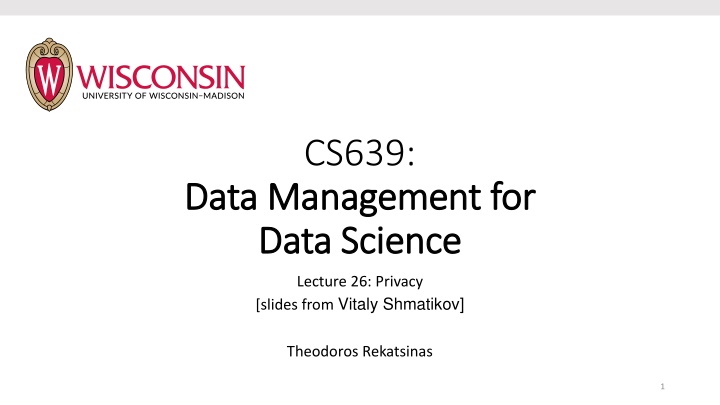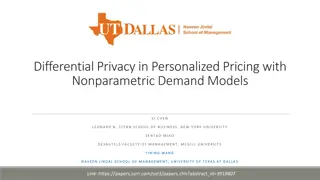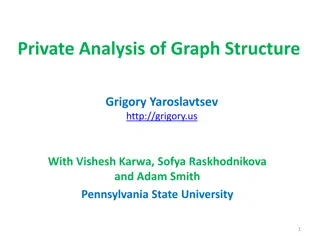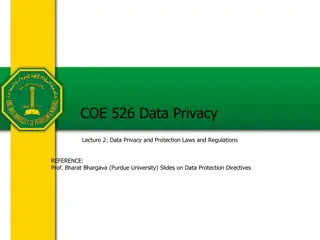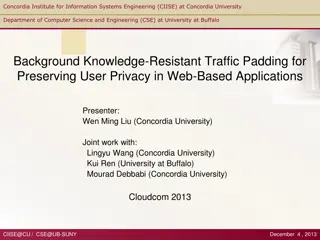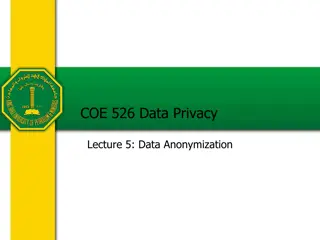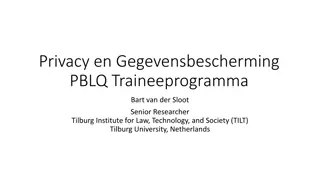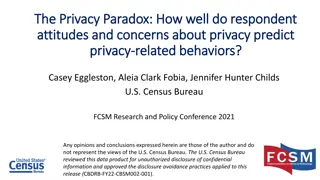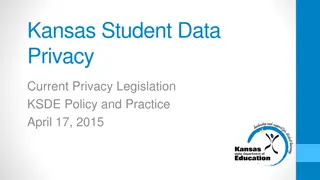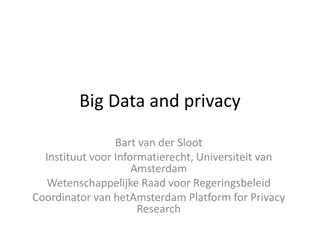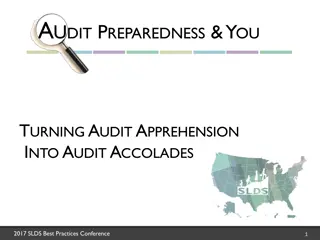Privacy Considerations in Data Management for Data Science Lecture
This lecture covers topics on privacy in data management for data science, focusing on differential privacy, examples of sanitization methods, strawman definition, blending into a crowd concept, and clustering-based definitions for data privacy. It discusses safe data sanitization, distribution revelation, privacy in group settings, and methods like k-anonymity for protecting individual data. The content highlights the importance of safeguarding personal information in various data processing scenarios.
Download Presentation

Please find below an Image/Link to download the presentation.
The content on the website is provided AS IS for your information and personal use only. It may not be sold, licensed, or shared on other websites without obtaining consent from the author.If you encounter any issues during the download, it is possible that the publisher has removed the file from their server.
You are allowed to download the files provided on this website for personal or commercial use, subject to the condition that they are used lawfully. All files are the property of their respective owners.
The content on the website is provided AS IS for your information and personal use only. It may not be sold, licensed, or shared on other websites without obtaining consent from the author.
E N D
Presentation Transcript
CS639: Data Management for Data Management for Data Science Data Science Lecture 26: Privacy [slides from Vitaly Shmatikov] Theodoros Rekatsinas 1
Reading Dwork. Differential Privacy (invited talk at ICALP 2006). slide 2
Basic Setting query 1 x1 x2 answer 1 Users (government, researchers, marketers, ) San x3 DB= query T xn-1 answer T xn random coins slide 3
Examples of Sanitization Methods Input perturbation Add random noise to database, release Summary statistics Means, variances Marginal totals Regression coefficients Output perturbation Summary statistics with noise Interactive versions of the above methods Auditor decides which queries are OK, type of noise slide 4
Strawman Definition Assume x1, ,xn are drawn i.i.d. from unknown distribution Candidate definition: sanitization is safe if it only reveals the distribution Implied approach: Learn the distribution Release description of distribution or re-sample points This definition is tautological! Estimate of distribution depends on data why is it safe? slide 5
Blending into a Crowd Frequency in DB or frequency in underlying population? Intuition: I am safe in a group of k or more k varies (3 6 100 10,000?) Many variations on theme Adversary wants predicate g such that 0 < #{i | g(xi)=true} < k Why? Privacy is protection from being brought to the attention of others [Gavison] Rare property helps re-identify someone Implicit: information about a large group is public E.g., liver problems more prevalent among diabetics slide 6
Clustering-Based Definitions Given sanitization S, look at all databases consistent with S Safe if no predicate is true for all consistent databases k-anonymity Partition D into bins Safe if each bin is either empty, or contains at least k elements Cell bound methods Release marginal sums brown blue 2 blond brown 10 12 6 18 16 12 14 brown blue [0,12] blond brown [0,12] 12 [0,16] 18 16 [0,14] 14 slide 7
Issues with Clustering Purely syntactic definition of privacy What adversary does this apply to? Does not consider adversaries with side information Does not consider probability Does not consider adversarial algorithm for making decisions (inference) slide 8
Bayesian Adversaries Adversary outputs point z D Score = 1/fz if fz > 0, 0 otherwise fz is the number of matching points in D Sanitization is safe if E(score) Procedure: Assume you know adversary s prior distribution over databases Given a candidate output, update prior conditioned on output (via Bayes rule) If maxz E( score | output ) < , then safe to release slide 9
Issues with Bayesian Privacy Restricts the type of predicates adversary can choose Must know prior distribution Can one scheme work for many distributions? Sanitizer works harder than adversary Conditional probabilities don t consider previous iterations Remember simulatable auditing? slide 10
Classical Intution for Privacy If the release of statistics S makes it possible to determine the value [of private information] more accurately than is possible without access to S, a disclosure has taken place. [Dalenius 1977] Privacy means that anything that can be learned about a respondent from the statistical database can be learned without access to the database Similar to semantic security of encryption Anything about the plaintext that can be learned from a ciphertext can be learned without the ciphertext slide 11
Problems with Classic Intuition Popular interpretation: prior and posterior views about an individual shouldn t change too much What if my (incorrect) prior is that every UTCS graduate student has three arms? How much is too much? Can t achieve cryptographically small levels of disclosure and keep the data useful Adversarial user is supposed to learn unpredictable things about the database slide 12
Impossibility Result [Dwork] Privacy: for some definition of privacy breach, distribution on databases, adversaries A, A such that Pr(A(San)=breach) Pr(A ()=breach) For reasonable breach , if San(DB) contains information about DB, then some adversary breaks this definition Example Paris knows that Theo is 2 inches taller than the average Greek DB allows computing average height of a Greek This DB breaks Theos sprivacy according to this definition even if his record is not in the database! slide 13
(Very Informal) Proof Sketch Suppose DB is uniformly random Entropy I( DB ; San(DB) ) > 0 Breach is predicting a predicate g(DB) Adversary knows r, H(r ; San(DB)) g(DB) H is a suitable hash function, r=H(DB) By itself, does not leak anything about DB (why?) Together with San(DB), reveals g(DB) (why?) slide 14
Differential Privacy (1) x1 query 1 answer 1 x2 x3 San DB= query T answer T xn-1 xn Adversary A random coins Example with Greeks and Theo Adversary learns Theo s height even if he is not in the database Intuition: Whatever is learned would be learned regardless of whether or not Theoparticipates Dual: Whatever is already known, situation won t get worse slide 15
Differential Privacy (2) x1 query 1 answer 1 x2 0 San DB= query T answer T xn-1 xn Adversary A random coins Define n+1 games Game 0: Game i: Given S and prior p() on DB, define n+1 posterior distrib s Adv. interacts with San(DB) Adv. interacts with San(DB-i); DB-i = (x1, ,xi-1,0,xi+1, ,xn) slide 16
Differential Privacy (3) x1 query 1 answer 1 x2 0 San DB= query T answer T xn-1 xn Adversary A random coins Definition: San is safe if prior distributions p( ) on DB, transcripts S, i =1, ,n StatDiff( p0( |S) , pi( |S) ) slide 17
Indistinguishability x1 query 1 answer 1 x2 x3 San transcript S DB= query T answer T xn-1 xn Distance between distributions is at most random coins Differ in 1 row x1 query 1 answer 1 x2 y3 San transcript S DB = query T answer T xn-1 xn random coins slide 18
Which Distance to Use? Problem: must be large Any two databases induce transcripts at distance n To get utility, need > 1/n Statistical difference 1/n is not meaningful! Example: release random point in database San(x1, ,xn) = ( j, xj ) for random j For every i , changing xi induces statistical difference 1/n But some xi is revealed with probability 1 slide 19
Formalizing Indistinguishability ? query 1 transcript S query 1 transcript S answer 1 answer 1 Adversary A Definition: San is -indistinguishable if A, DB, DB which differ in 1 row, sets of transcripts S (1 ) p( San(DB ) S ) p( San(DB) S ) p( San(DB) = S ) p( San(DB )= S ) 1 Equivalently, S: slide 20
Indistinguishability Diff. Privacy Definition: San is safe if prior distributions p( ) on DB, transcripts S, i =1, ,n StatDiff( p0( |S) , pi( |S) ) For every S and DB, indistinguishability implies This implies StatDiff( p0( |S) , pi( | S) ) slide 21
Sensitivity with Laplace Noise slide 22
Differential Privacy: Summary San gives -differential privacy if for all values of DB and Me and all transcripts t: e 1 Pr[ San (DB - Me) = t] Pr[ San (DB + Me) = t] Pr [t] slide 23
